









|
|
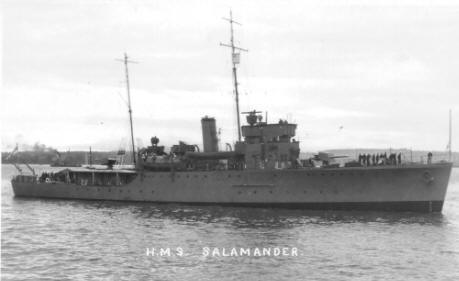
HMS Salamander
|
Date of Arrival |
Place |
Date of Departure |
Orders, Remarks etc |
|
1.1.40 |
Humber |
11.2.40 |
2/1 From FO i/c Humber:
Intend to take SALAMANDER in hand for 14 days refit at Grimsby,
commences 6/1
7/1: Taken in hand 7/1
completes 21/1
9/1 From Emergency
Repairs Overseas, Hull: SALAMANDER is docking at Grimsby 10/1
26/1 from FO i/c Humber:
Owing to further machinery defects SALAMANDER’s date of completion
postponed to 1/2
4/2 from F O Humber:
Completed 3/2 |
|
12.2.40 |
Invergordon |
19.2.40 |
15/2 From C in C Rosyth
SALAMANDER standing by derelict off Lybster |
|
21.2.40 |
Invergordon |
28.2.40 |
|
|
1.3.40 |
Humber |
19.3.40 |
|
|
|
CLICK HERE for Salamander
Minesweeping Reports 1940
'The mine swept
was marked ‘For Winston Churchill’. '
|
|
20.3.40 |
Dover |
27.3.40 |
|
|
? |
Downs |
5.4.40 |
By April SALAMANDER had
been reassigned to the 4th M/S Flotilla, also in the Nore Command |
|
5.4.40 |
Harwich |
5.4.40 |
|
|
5.4.40 |
Harwich |
6.4.40 |
|
|
7.4.40 |
Humber |
? |
|
|
Between 4 and 15 May she
took part in a minesweeping operation off the Dutch coast, and towards
the end of the month she joined Group 3, one of many groups organised
to evacuate the B.E.F from Dunkirk (Operation 'Dynamo')
Ruegg |
|
12.5.40 |
Harwich |
14.5.40 |
|
|
15.5.40 |
Harwich |
16.5.40 |
Escorting Dutch
minesweeper |
|
16.5.40 |
Humber |
23.5.40 |
|
|
24.5.40 |
Humber |
26.5.40 |
|
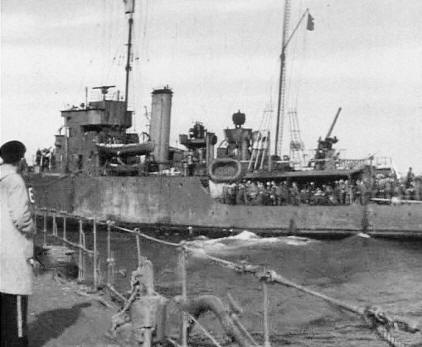

These photo's are believed to
show HMS Salamander transferring troops from Dunkirk (probably onto
HMS Calcutta).
They were taken from the
British Pathe film
''TIME TO REMEMBER - RUN RABBIT RUN'
which can be seen
HERE
(Ship briefly glimpsed approx 3 min 10 secs into film)
(Copies of the photo's and the original footage can
be purchased from the British Pathe site.)
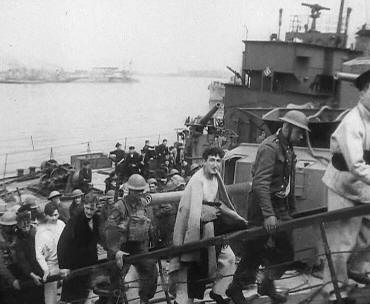
Troops disembarking across a
destroyer from a Halcyon Class Minesweeper which appears to be
Salamander (behind)
|
Source: Orde
HMS SALAMANDER at Dunkirk
|
|
26.5.40 |
2000 |
Left the
Humber, under orders of the minesweeper Sutton, in company with the
minesweepers Sutton and Fitzroy |
|
27.5.40 |
1510 |
Anchored in
the Downs |
|
28.5.40 |
1540 |
Proceeded
under orders of Sutton, in company with Sutton and Fitzroy via R, S
and T buoys, to
Dunkirk
roads. |
|
|
- |
Rendezvoused
with the minesweepers Halcyon and Skipjack by S buoy, and proceeded in
company. |
|
|
2130 |
Anchored off
La Panne. Using motor boat and whalers embarked 150 troops during the
night. |
|
29.5.40 |
0900 |
Transferred
150 troops to the cruiser Calcutta. Proceeded back to La Panne and
embarked troops by ship's boats and small pulling boats. |
|
|
1600 |
Air attack by
Ju87's. The destroyer Greyhound, one cable distant, was hit (she
received 2 near misses) as were several small ships. |
|
|
1730 |
Proceeded via
Dunkirk
Roads. Air attack. Dunkirk and neighbouring beaches heavily bombed.
Proceeded via T, S and R buoys in company with Sutton. |
|
|
2320 |
Anchored off
Dover
in fog. |
|
30.5.40 |
0740 |
Alongside
Admiralty Pier. Disembarked 289 troops. |
|
|
1610 |
Proceeded to
Dunkirk
roads, via U, V and W buoys |
|
|
2100 |
Anchored off
Bray. Embarked 397 men during the night. Closed the destroyer Shikari
and embarked Brig Gen Holden and a staff officer. Transferred the
motor boat to the destroyer Icarus which had no power boat. |
|
|
- |
Proceeded to
Dover
via W, V and U buoys |
|
31.5.40 |
0810 |
Arrived
Dover.
Disembarked 393 troops. |
|
|
1800 |
Left Dover in
company with Halcyon and Skipjack to rendezvous with the remainder of
the minesweepers at W buoy in accordance with Vice Admiral Dover's
0357/31/5. |
|
|
2200 |
At W buoy,
SALAMANDER took the Fitzroy under her command, and "followed astern of
the other two groups" through Dunkirk roads, past Dunkirk, to a
position off Bray. Was then ordered by Niger to anchor 1 mile
to his eastward, to avoid magnetic mines laid near No.8 buoy. |
|
1.6.40 |
0015 |
Anchored
accordingly. The beach at Bray under enemy shrapnel fire. Sent the
ship's whaler inshore. |
|
|
0050 |
The whaler
returned with a message from General Montgomery to inform all ships
that he intended moving westward to Dunkirk at once, as the beach was
becoming untenable. The message was passed to all ships in V/S touch.
The pontoon pier had been hit by shell fire; no troops were embarking
so SALAMANDER got under way and closed the beach as closely as
possible. |
|
|
0300 |
Troops began
to come off in boats and were embarked. Rear Admiral Dover ordered all
ships to embark men in boats and then move to Dunkirk at dawn. |
|
|
0600 |
About 450
troops had been embarked including 29 wounded and 11 stretcher cases.
A bombing attack took place but no ships were hit. One casualty in
SALAMANDER from machine gun fire. |
|
|
- |
SALAMANDER
proceeded westward, astern of the destroyer Keith and the minesweeper
Skipjack. |
|
|
0820 |
Air attack on
all three ships. Skipjack was hit and sank. Keith was hit and set on fire;
she abandoned ship. SALAMANDER closed Keith and sent away both
whalers. |
|
|
- |
Whilst
rescuing survivors, attacked by Ju87 dive bombers. A salvo of 4 bombs
fell about 50 feet ahead; 2 of these exploded under water abreast
SALAMANDER's bridge. The ship lifted bodily, heeled to starboard, and
then settled down with a list to port. She then sank about a foot -
suddenly. Believing the ship to be sinking, the confidential books
were thrown overboard in a weighted bag. The Engineer Officer and the
1st Lieutenant reported that the ship was still seaworthy, but that
she had gained a foot draught because of flooded compartments. Damage
in the engine room had caused the steam pressure to fall. After about
15 minutes, steam was raised for slow speed. |
|
|
0915 |
Air attack; a
salvo of bombs fell on the port quarter, 50 yards astern. SALAMANDER
was about to proceed, leaving the whalers to assist picking up Keith's
survivors and to take them to a tug (St Abbas) standing by, but
captain then on the bridge of the tug asked SALAMANDER to destroy
Keith's asdic dome. Having no H.E. left, SALAMANDER destroyed the dome
with two rounds of SAP. |
|
|
- |
SALAMANDER
proceeded to
Dover
with 480 troops, via W, V and U buoys. |
|
|
- |
Off W buoy an
air attack was driven off by machine gun and rifle fire. |
|
|
1530 |
Arrived
Dover
on one boiler. Disembarked 479 troops, |
|
|
Source
http://www.bbc.co.uk/dna/ww2/A2276426
Extracts from - Dunkirk Evacuation: A Young Guardsman's Story – Frank
Fletcher
Next two minesweepers appeared, the troops left on the beach were
mainly guardsman, Grenadiers and Coldstreams, the remains of a
Scottish regiment and a few stragglers who hoped someone would get
them home.
A Corporal and myself swam out and salvaged a Carley Life float, it
held 4 of us and we tried to get out to nearest ship. With the tide
coming in we didn’t make a bit of progress but a lifeboat full of
Scottish Troops commanded by a CSM who obviously fancied himself as a
sailor threw us a line. We made it to the nearest minesweeper, the
SALAMANDER, the other being the Speedwell
(Note: May be Skipjack?). We
later described the SALAMANDER, one funnel, one gun and one
hope to get back. The German planes returned to give us the full
treatment, a stick of bombs dropped between the boats, nearly
capsizing the Speedwell and causing steam to come out of the
SALAMANDER through holes that were never on the Admiralty
drawings. However they were built of strong stuff and lived to fight
another day. The hoist to the 4.5 gun went up in smoke and the shells
had to be manhandled to the gun deck, the empties were dumped over the
side burning and blistering the hands.
The morning wore on and we cruised up and down the beach taking on
board any of the troops that made it to the nets slung over the sides.
The 4.5 kept banging away helped by several Bren guns taken on board
by the troops. I did ask the Petty Officer in charge of the gun
whether we would get back. He said and I quote “Son I volunteered for
this ship, the British Navy has never lost a SALAMANDER yet
through enemy action”. As it survived several Russian convoys later in
the war his confidence was not misplaced.
The Germans were still trying to sink us. One ME110 received a direct
hit above us and dived into the sea. The final few shells were being
manhandled to the gun deck, a few more planes flew over but for once
they were ours. The troops on deck gave them a cheer and toasted them
in Navy cocoa. It was thick enough to cut but as the first hot drink
for several days there were no complaints.
Having loaded our quota we turned and headed to the open sea and the
white cliffs of
England.
|
|
|
Source:
http://www.thisisoxfordshire.co.uk/oxfordshire/archive/2000/05/23/NEWS0ZM.html
The
worst experience of my life
by This is Oxfordshire
23.5.2000
A 99-year-old war hero
has been reliving the horrors of Dunkirk at a final gathering of
wartime comrades.
Former naval officer
William 'Bill' Stone was 40 years old when his ship was ordered to
the French coast to help rescue thousands of stranded soldiers. But
the scenes of carnage that greeted him 60 years ago have stayed with
him ever since.
Over 300,000 British
and French troops were saved from the German onslaught in 1940 by
British sailors and fishermen, some in tiny boats.
To mark the anniversary
of the historic evacuation, Mr Stone, of Orchard Walk, Watlington,
met other survivors of the heroic evacuation for the final reunion
of the Dunkirk Veterans Association.
Mr Stone, who will be
100 in September, is the oldest member of the association, which is
to be disbanded due to the age of its members. He said this year's
gathering at London's Imperial War Museum was a last chance to meet
many old friends. For Mr Stone, who was chief petty officer on the
minesweeper HMS SALAMANDER, Dunkirk was a rude awakening to the
reality of war. Although he joined the Royal Navy on his 18th
birthday, in the final weeks of the First World War, he had not seen
active service until arriving on the French coast.
He said: "Dunkirk was
the worst experience of my life. It was terrible and got worse as it
went on".
"I saw hundreds of
people killed in front of me. Some had no clothes on and were shot
and bombed as they swam out to boats. There were oil tanks burning,
ships sinking and hundreds of soldiers lined up on the beaches. Our
sister ship HMS Niger (in fact it was Skipjack) was bombed 50 yards in front of us and 200
people were killed."
The SALAMANDER made
five trips between Dover and Dunkirk, rescuing over 1,000 men. At
one point it narrowly avoided being sunk after being targeted by a
German U-boat. Mr Stone has an impressive collection of 12 medals,
including campaign medals for Africa, Italy, France and Germany, and
was mentioned in dispatches.
After the war Mr Stone
bought himself a barber's shop in Devon. The widowed father of one
and grandfather of two came to Watlington 15 years ago. He said the
secret of his long life had been "clean living and trust in God".
He added: "Experiences
like Dunkirk make you religious. I used to drink a lot of rum and
smoke 50 a day, but not any more. Someone once told me I had stayed
youthful because I was pickled inside."
|
|
|
http://www.hmshood.com/crew/bios/WilliamStone_Bio.html
We did five trips to Dunkirk in all, rescuing 200 to 300 men each
time. Things got worse each trip we made. Our final trip was on 1st
June by which stage there was the wreckage of sunken ships all
around and burning oil tanks by the dockside. Lines of troops were
all marching towards the sea. We were anchored off the beach with
one of our sister ships, the 'Skipjack', only about fifty yards
away. At about 8am the German dive bombers came over and attacked
'Skipjack.' One of the attacking planes was shot down but 'Skipjack'
was badly hit and capsized. She must have had about 200 men on
board. I had to say "God, help us." I believe to this day that He
did.
During our trips to Dunkirk, I was often stationed on the
quarterdeck helping men get aboard "Salamander" as they swam out
from the beach. Other groups of men had managed to find boats and
row out to the ship. On one occasion I had a rope around a badly
injured soldier who had bones sticking out of his trousers. Just as
I tried to pull him in, the ship went ahead and I lost him. I don't
know what happened to him.
Unknown to me, on our way back on the final trip, we were attacked
by a submarine that fired a torpedo at us. When we got back to Dover
the Coxswain and the Able Seaman on the wheel said to me "Chief, we
held our ears today and waited for the explosion. Jerry fired this
torpedo that was coming straight for us amidships." "Salamander" had
been saved by her shallow draft - the torpedo had passed straight
underneath us. The only explanation that we could think of to
explain our lucky escape was that the German submarine had mistaken
us for a destroyer and had set the torpedo to run at a greater depth
than the "Salamander's" draft.
Those were awful days but one just carried on as if nothing had
happened - there was nothing else that you could do.
In all the years since Dunkirk I had never come across anyone whom
we had rescued in the "Salamander" until the summer of 1999. It was
then that, whilst at a reunion of the Henley Branch of the Dunkirk
Veterans Association, a chap came up to me and said, "What ship were
you in at Dunkirk, Chief?" "Salamander," I replied. "You saved my
life," he said. He told me that he had broken into a boat shed at De
Panne in Belgium with some other soldiers and pinched a rowing boat.
They had started to row home when we picked them up. It is pretty
unlikely that they would have made it all the way back across the
Channel in the rowing boat.
Following Dunkirk "Salamander" was put in to the Royal Albert docks
in London to undergo repair to the damage that had been sustained
during the evacuation.
|
|
|
Our forward troops met the
Germans at Louvain and had to retreat. We manned GP's in Brussels
covering blown bridges then joined the retreat to Dunkirk.
Unessential personnel were evacuated first and then the rest took
the guns and equipment to the beach and destroyed them. I made my
way across the beach near La Panne during the night and waded into
the Channel to be picked up by a boat from HMS Salamander which
dropped us off at Dover on June 1st.
When I entered the Channel I was wearing gumboots which slid off to
the bottom but the crew of Salamander found me a pair of shoes to
wear until we reached an assembly point near Maidenhead.
John Waugh B.E.F
|
|
|
Message from the son of a
soldier rescued by HMS Salamander
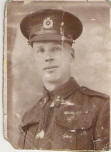 I would just like to say
thank you to all the lads that are still alive, who served on the
Salamander for getting my Father, Spr John James Latham 108 Royal
Engineers (Territorial BEF) away safely to "Calcutta" and thence to
Sheerness. My Father's diary quotes all details accurately, how they
swam to the Salamander at 10.00pm on the evening of 28th May, and
remained with you all night as you picked up others, leaving aboard
the Calcutta at 2.15pm for Sheerness. I would just like to say
thank you to all the lads that are still alive, who served on the
Salamander for getting my Father, Spr John James Latham 108 Royal
Engineers (Territorial BEF) away safely to "Calcutta" and thence to
Sheerness. My Father's diary quotes all details accurately, how they
swam to the Salamander at 10.00pm on the evening of 28th May, and
remained with you all night as you picked up others, leaving aboard
the Calcutta at 2.15pm for Sheerness.
I was only 2 1/2 at the time, but reading the Salamander's ships log
of the terrible events you endured in the subsequent days, I feel
very proud of you all. There must be so many families who have
thanked you for bringing their men back home safely, yet are totally
unaware of such courage and heroism.
God bless all who are still with us, and "well done lads" to those
who are not.
Kindest Regards
John Latham
P.S. Father was 43 years old at the time, and had already done his
bit in the 1914 - 18 war. He must have been born under a lucky star.
July 2007
CLICK HERE to see full extracts from
the Diary
|
|
1.6.40 |
Crew members who died 1st
June 1940:
Able Seaman Edwin Adams
D/SSX16420, aged 31
Able Seaman Arthur Dene Trevor Benyon DSM, D/JX142424, age 21
Stoker 1st Class Charles Priestly D/KX93761
Ordinary Seaman William Simpson D/JX 158273
Stoker 1st Class Henry Joseph Thompson DSM, D/KX93732,
age 20.
|
|
|
|
Total troops
transported: 1161 |
|
|
|
The following awards were
made: |
|
|
|
DSO Lt Cdr L J S Ede RN |
|
|
|
DSC Commd Engr T E Reynolds |
|
|
|
DSM A.B. A D T Benyon |
|
|
|
? Sto 1st Cl. H J Thompson |
|
|
|
Mention in
Despatches L/Sig J Thomas |
|
|
|
Mention in
Despatches L/Sto A Hussey |
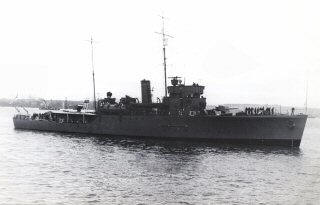
|
Date of Arrival |
Place |
Date of Departure |
Orders, Remarks etc |
|
? |
Dover |
2.6.40 |
|
|
2.6.40 |
Sheerness |
2.6.40 |
|
|
3.6.40 |
London |
10.7.40 |
4/6 From F O i/c London:
Taken in hand at Green & Silley Weir, Royal Albert Dock; estimated
period to complete 3 to 4 weeks
D of D 13/6 Completes 1/7
approx dependent on receipt of LL Sweep gear
Delayed by defects,
completes 11/7 |
|
12.7.40 |
Sheerness |
14.7.40 |
|
|
14.7.40 |
Humber |
? |
|
|
30.7.40 |
Harwich |
30.7.40 |
|
|
From: The Senior Officer Sixth Minesweeping
Flotilla
Date: 8th August 1940
To: The Flag Officer in Charge, Harwich
Subject: Operations of Sixth Minesweeping
Flotilla
The following report of the movements of the
Sixth Minesweeping Flotilla since their arrival at Harwich on 17th
June are submitted. (The 6th MSF was joined by the 4th
MSF – SALAMANDER - for this part of the operation)
30th
July Sweeping Channel XYZ with four fleet sweepers ahead of
convoys. SUTTON, SALAMANDER, SELKIRK joined company at 1000. 1218
and 1229 engaged single enemy aircraft. 1625-2130 Harbour. Then
anchored Shipway.
31st
July Sweeping XYZ with six fleet sweepers. 1500 sighted single
enemy aircraft. 0810 ELGIN and DUNDALK joined company at sea.
Returned to Harwich.
1st
August Sweeping XYZ with fleet sweepers (seven).
2nd
August Sweeping convoys through XYZ with seven sweepers. Sweeping
new channel close to Shipwash. Sweeping H34 back to Harwich. 1715
sighted 20 twin-engined enemy bombers. HARRIER joined flotilla on
return to Harbour.
3rd
August HALCYON harbour. Six Fleet sweepers sweeping convoys
through XYZ channel.
4th
August Clearing sweep new channel close to Shipwash 20’ X 2’. Poor
visibility. 2 mines cut. 1200 SPEEDWELL rejoined flotilla. 1623,
anchored in thick fog. (Eight Fleet sweepers.)
5th
August Continued at dawn. Completed channel 2000. Anchored
Shipway. 0640 one mine each cut by HUSSAR, SPEEDWELL and HARRIER in
position 201’ 3.2 miles from 54A buoy while sweeping outer eastern
lap of channel.
6th
August Clearing channel joining new channel, eight Fleet sweepers.
Completed clearance 2115. Anchored Shipway.
7th
August High percentage search…with eight fleet sweepers…Sweeping X
to Y on return. Returned to Harwich.
Some minor actions against aircraft have been
omitted from the report but, like all Flotillas operating in this
vicinity, hostile aircraft have been engaged almost daily.
I consider that all officers and men in the
Flotilla have carried out their duties cheerfully and efficiently
...
R P Hinton
Commander
Senior Officer Sixth Minesweeping Flotilla
Comment from:
The Flag Officer in Charge, Harwich, 12th August 1940
The operations
covered by these reports entailed a degree of hard work,
determination and technical skill which reflects the highest
credit on all concerned and showed a very fine spirit to exist in
the Minesweeping Force at Harwich.
Admiral
12th August 1940
Comment from: R
Drax, Admiral, The Nore, 14th August 1940
The remarks of the
Flag Officer in Charge, Harwich are fully concurred in. The zeal and
devotion to duty of the minesweeping flotillas deserve the fullest
recognition that can be given, particularly in view of the fact that
their work is done out of sight and in the constant expectation of
air attack. Very early recognition would be very welcome and
specially appropriate at the present time.
|
|
? |
Harwich |
1.8.40 |
See above
|
|
2.8.40 |
Harwich |
2.8.40 |
See above
|
|
3.8.40 |
Harwich |
3.8.40 |
See above
|
|
7.8.40 |
Harwich |
15.8.40 |
|
|
16.8.40 |
Harwich |
17.8.40 |
|
|
17.8.40 |
Harwich |
20.8.40 |
|
|
21.8.40 |
Humber |
31.8.40 |
|
|
1.9.40 |
Harwich |
1.9.40 |
|
|
2.9.40 |
Harwich |
4.9.40 |
|
|
4.9.40 |
Harwich |
10.9.40 |
|
|
10.9.40 |
Harwich |
15.9.40 |
|
|
16.9.40 |
Harwich |
20.9.40 |
|
|
21.9.40 |
Harwich |
24.9.40 |
|
|
24.9.40 |
Sheerness |
25.9.40 |
On 25/9 SALAMANDER was to
take part in Operation Lucid (originally ‘Lucifer’). She was to help
to escort one of two old merchant ships filled with fuel oil and high
explosives across the channel to Calais to be set loose as ‘fire
ships’ amongst the gathering German invasion fleet. The ships set sail
but were recalled due to bad weather. Bad weather prevented further
attempts and the idea was eventually dropped.
Source: Jack Williams - Fleet Sweepers at War |
|
? |
Sheerness |
26.9.40 |
|
|
27.9.40 |
Harwich |
2.10.40 |
Coastal convoy duties
until December |
|
2.10.40 |
Harwich |
12.10.40 |
|
|
|
CLICK HERE for Salamander
Minesweeping Reports 1940
|
|
13.10.40 |
Harwich |
13.10.40 |
|
|
14.10.40 |
Harwich |
17.10.40 |
|
|
? |
Harwich |
19.10.40 |
|
|
21.10.40 |
Harwich |
22.10.40 |
|
|
25.10.40 |
Harwich |
27.10.40 |
|
|
27.10.40 |
Harwich |
28.10.40 |
|
|
29.10.40 |
Harwich |
9.11.40 |
|
|
|
|
|
Then early in November 1940 first job. Block ship for St Nazaire. Two
block ships (old tramper ships filled with concrete) were towed by
MTB’s (Motor Torpedo Boats) from Falmouth (50n08, 5w04) (between 14:00
-15:00) to saint Nazaire. Once the blocks ships were in St. Nazaire
harbour the sea cocks were opened and dad jumped into the water along
with the other operatives. They then had to swim across the harbour
back to the MTB’s. The only lights on were the small red lights on the
life jacket worn by each operative. Once picked up by the MTB’s
everyone was then taken back to HMS Salamander.
Source: Alan Gould whose father Jack Gould served on Salamander |
|
10.11.40 |
Harwich |
11.11.40 |
|
|
11.11.40 |
Harwich |
15.11.40 |
|
|
15.11.40 |
Harwich |
18.11.40 |
|
|
18.11.40 |
Harwich |
25.11.40 |
|
|
25.11.40 |
Harwich |
27.11.40 |
|
|
27.11.40 |
Harwich |
29.11.40 |
|
|
29.11.40 |
Harwich |
20.12.40 |
7/12 From F O i/c
Harwich: Regret to report damage to SALAMANDER during heavy gale 6/12.
Can be made seaworthy by 9/12 |
|
21.12.40 |
Harwich |
29.12.40 |
|
|
29.12.40 |
Harwich |
3.1.40 |
|
|

